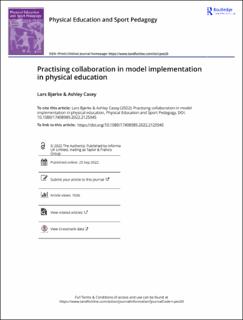| dc.description.abstract | Background: Over the last two decades, teachers’ use of models has been frequently highlighted as a possible future for physical education. Literature has also shown that collaborations between teachers and researchers can be effective in supporting teachers not only to successfully implement but also sustain their long-term use of models Despite this evidence, the practice of collaboration itself has so far, at best, been an implicit focus for investigation and the ways in which collaborations are practised seem to vary. Purpose: In this paper, we argue that there is a need to move beyond stating that collaborations work and understand more about the different ways collaborations between teachers and researchers might be practised. We do so by presenting three empirical illustrations which represent different collaborative practices and discuss the consequences these have for teachers’ implementation of models. Methods: The empirical illustrations draw on data from teacher interviews, recorded workshops and the first author’s reflective research diary collected over a two-year collaborative project. Through a cyclical and iterative process of analysing the data we identified three ways in which the practice of collaboration was practised: ‘the researcher knows best’, ‘basing learning on the needs of the teachers’ and ‘the end of the beginning’. To further our understanding and discuss the consequences of these practices, we used practice architectures , models-as-specification versus models-as-prescriptionand fidelity to procedure versus fidelity to goals as theoretical concepts. Illustrations: The ‘researcher knows best’ illustration represents a collaboration in which the researcher believes they know best about what the teachers should learn and what they would benefit from most. Hence, the researcher provided knowledge about how and why pedagogical models could be implemented, without consulting the teachers. The second illustration, ‘basing the learning on the needs of the teachers’ investigates how the researcher tried to learn from their on-going experiences and adjust the way they approached the collaboration with the teachers, to increase the level of teacher autonomy. The third illustration, ‘the end of the beginning’ shows a collaboration in which the researcher deliberately took a more peripheral role. This allowed the teachers to decide both on what they needed to learn and how this could be achieved. Conclusions: Although our theoretical concepts allowed us to problematize different aspects of all these practices, it is not our ambition to say that there is a right or wrong way of working together to enable teachers to implement models. Indeed, we suggest that to collaborate is something that needs to be continuously practised by both teachers and researchers to respond to the different needs at different times in the process of collaboration. In conclusion, we suggest that planning for collaborations that; (1) allow models to be considered as specifications for practices and (2) allow fidelity to be considered in relation to the overall purpose of the model, could serve as two guiding principles for future collaborations. | |

